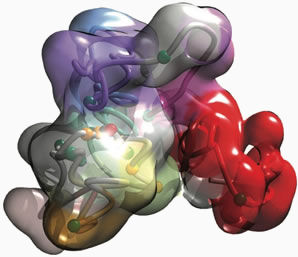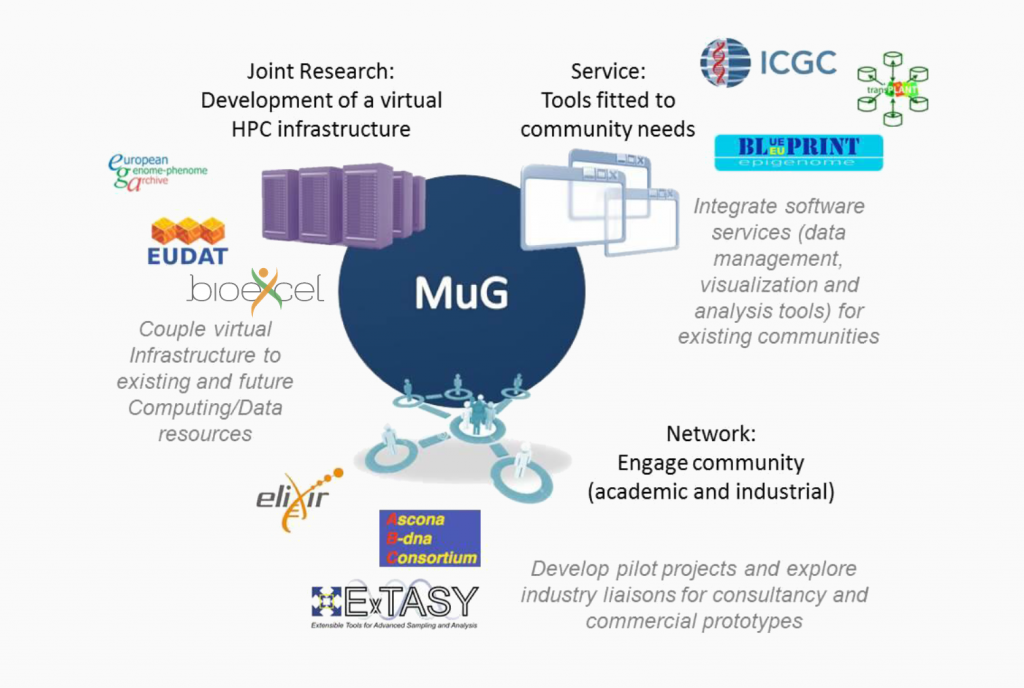MuG at a Glance
Coordinator: Dr. Modesto Orozco (IRB Barcelona)
Start date: 1st November 2015
Project duration: 36 months
Total Project Cost: 2.961.163,75 €
Research efforts in 3D and 4D genomics are experiencing exponential growth. However, the current lack of standardization in analysis and simulation tools is threatening to become a bottleneck. MuG responds to the latest computational challenges of 3D/4D genomics by connecting this community to the HPC world and providing a suitable set of tools and infrastructure.

The Challenge of 3D and 4D genomics

3D and 4D genomics represent one of the greatest challenges for biology and biomedicine in the next decade.
Understanding how genome is organized in the space and how this affects gene regulation would be instrumental to fully understand the time-dependent connection between genome and phenome.
The vision of the MuG project lies on the achievement of the following challenges:
- To prevent a potential collapse in 3D/4D genomics due to inability to manage the computational problems originated by massive sequencing experiments and simulations.
- To nucleate the 3D/4D community and bring it closer to the HPC and Big Data world.
- To provide an integrated three-dimensional picture of the genome
Objectives
- To stimulate and engage the active and growing biology community to interact with the HPC and Big Data world through the development of user oriented solutions. This is to be achieved by defining standards in software and data and creating a sustainable, HPC-optimized infrastructure to foster research in this field.
- To develop, benchmark, standardize, and integrate in common workflows multi-physics simulation and analysis tools used in 3D/4D genomics.
- To create a toolbox of HPC ready software for higher-scale simulations and for structural analysis of experimental data.
- To create a common data infrastructure, generate a common database repository, generate the required data ontology, and integrate 3D/4D data with structural and 1D genomics databases.
- To create the first ever multi-resolution genome-browser with new visualization tools able to move from 1D genomics, to low- and even high-resolution levels.
- Through pilot studies to prove the strength of the developed methodology: improved understanding of chromatin structure and dynamics and other biologically relevant topics.
Key Innovations
MuG goes beyond the state of the art in different fields:
- Connection of 1D to 3D/4D genomic data in a single data paradigm. This allows MuG to navigate through different scales using the appropriate model at each scale.
- Visualization of complex genomic machinery with a 4D multiresolution picture. MuG will provide an integrative way to simulate entire chromatin at different levels of resolution.
- Modelling of chromatin re-organizations, linked to different needs and/or pathological state of the cells.
- A new paradigm for synergistic collaborations between experts in the 3D/4D genomics community, including a new scheme for interaction with the HPC world.
User Driven
Impacts
Genomics and personalized medicine research community
Biosimulation and 3D Genomics community
HPC for Life Sciences initiatives
Users of European Infrastructures for HPC/Big Data
Genomics research community
Computer Science research community
Sequencing instrument vendors
Biotech/Pharma and Public Health

